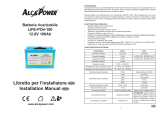
8
Clean the surface of battery with dry cloth, please don’t use oil or other volatile
organic solvents to clean, or it may damage it.
Please make sure that the positive (+) & negative (-) polarity is correct connected, or
it may fire or damage the battery and load.
Start testing the equipment if it could be well working with battery.
Using and maintenance
8.3 Battery Using and Maintenance
Charging current should be less than maximum charge current specified in the
Product Specification, charging current bigger than recommended current may
damage the battery.
Discharging current should be less than maximum discharge current specified in
the Product Specification; discharging current bigger than recommended current
may damage the battery.
Discharge temperature:-20℃~+60℃.Humidity:RH≤85%.When the temperature is
higher than 45℃, please note ventilation. When the environment humidity is higher
than 85%, please pay attention to protection. Charging
temperature:0℃~+45℃.Humidity: RH≤85%, When the environment humidity is
higher than 85%, please pay attention to protection; storage temperature:
0℃~40℃(Best temperature is 15℃~25℃in dry environment). Temperature
affects the capacity of battery obviously, it’s normal.
When the battery power is low, please charge it in time. This could ensure longer
cycle life. If the battery can’t be charged in time and let it under power shortage
condition, it may affect the cycle life.
The lithium-ion battery charge discharge shallow is beneficial to improve the
cycle life, proposal user each discharge is put to the nominal capacity of 80%.
It should be noted that the cell would be possible to be at the over-discharged state
by its self-discharge characteristics in case the cell is not used for long time. In
order to prevent over-discharging, the cell shall be charged periodically to maintain
a certain voltage range 13.2V~13.6V, 2months one cycle,Over-discharging may
causes loss of cell performance, characteristics, or battery functions. But
for battery packs with commnunication fuction, please maintain it once in 1 month.
Don’t use organic solvents to clean the battery case. If for battery fire accident,
please use dry powder fire extinguisher or sand.
Battery is a consumable product with limited cycle life. Please charge it in time when
the capacity can’t reach the requirement to avoid any loss of the user.
8.4 Battery Common Troubles and Solutions
Battery voltage is too low after fully charged.
Battery was in long-term storage with no usage, not in accordance with the provisions
for maintenance either.
Solution: charge the battery can be solved.











